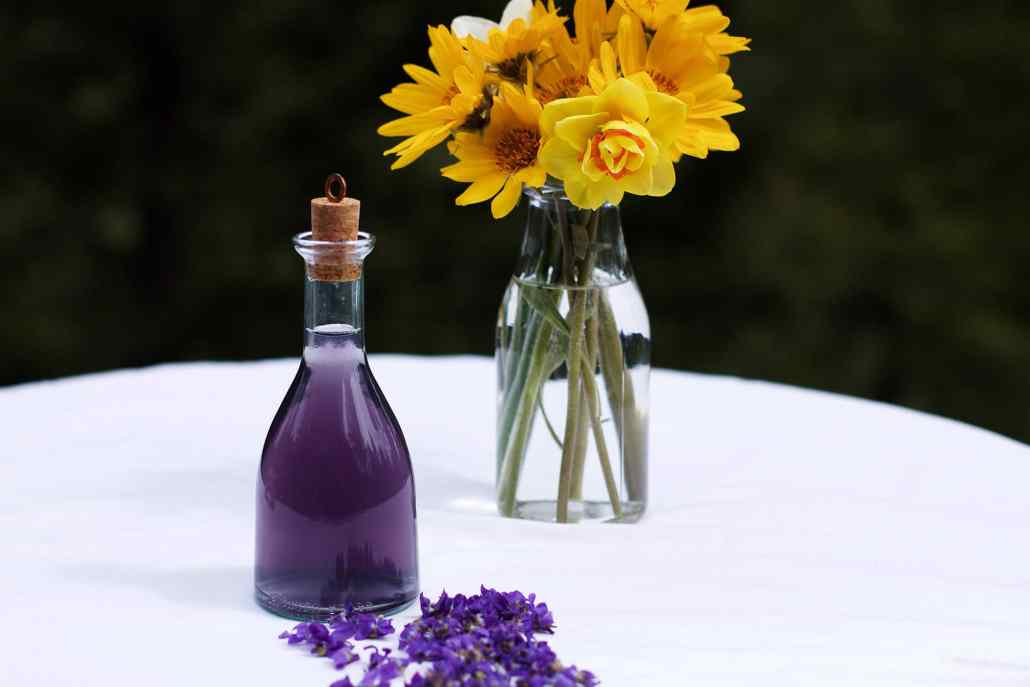
How to Make Violet Syrup & Violet Health Benefits
As early spring emerges, violets lift their nodding head to the sun, bringing beautiful blooms to gladden the hearts of all around them.
Many violet species are so intent on flowering they do it twice! The colorful blooms we are most familiar with are sometimes followed by more indiscreet self-pollinating flowers later in the season. In this way violet has a backup plan to ensure it is spreading seeds far and wide. And thank goodness for that!
To say that a flower can lift our hearts may sound esoteric to some, but if you spend some time with this precious plant, I’m sure you’ll be easily convinced. As I went to harvest the flowers for this recipe, my heart was sad with all the challenges we are facing right now. Kneeling on the earth, surrounded by purple blooms; feeling the sun on my skin; hearing the phoebes, robins, and blackbirds foraging nearby; and breathing in the fresh air was the best remedy for lifting my spirits.
Violet (Viola spp.) can be enjoyed as a culinary delight or relied upon for its medicinal gifts. Violet especially shines for problems associated with heat and dryness. Being high in mucilage, both violet leaves and flowers are moistening and soothing.
For Colds and Influenza: Dry Coughs, Sore Throats, and Fevers
Violets have long been used for coughs in Native American, European, and Chinese medicine. One double-blind randomized clinical trial with children aged 2 to 12 years found that violet syrup could help the coughs of children with intermittent asthma.1
Violet can also soften and soothe a sore throat, especially when it is dry and irritated. It can be used to bring instant relief as a tea, syrup, or infused honey.
For Congested Lymph
Violet is revered for moving stuck and stagnant lymph and has traditionally been acclaimed for softening hardness in glandular tissues. There are a variety of ways that violet can be used.
Taken as a tea, syrup, or fresh tincture, violet can address hot and swollen lymph nodes associated with upper respiratory infections.
Taken internally and applied externally (as a poultice or infused oil), violet can gently move swollen lymphatic glands in the breasts, armpits, groin, or any other area feeling stuck and stagnant.
You can read more about violet in my monograph on HerbMentor.
Where to Find Violet
Violets love to grow in moist and shady places. I often find native violets growing near streambeds underneath a canopy of shrubs and trees. I love to spend time with these delicate plants! However, I reserve my violet harvest for the abundant and weedy violet species that have found their way into feral meadows and lawns.
If you aren’t sure where violet may be growing near you, ask around! You may be surprised to find a neighbor or friend who has a large supply. A couple years ago while walking around inner city neighborhoods in Portland, Oregon, I was surprised to see many yards filled with violets!
You can also consider growing violets. For the past several years, I’ve been planting violet starts all over my yard in the hopes of having gobs of flowers one day! (I buy my violet starts [Viola odorata] from Crimson Sage Nursery).
Where I live violets start to bloom around the same time as dandelions.
How to Identify Violet
You can find violets throughout the world, though they mostly occur in northern temperate climates. There are up to 600 different species of violets. There also are many modern cultivars used in gardens (often called pansies or Johnny-jump-ups).
While many species of violet flowers are indeed purple, as the name violet implies, the flowers of the Viola genus range from white to yellow to blue and purple. They can also be multicolored.
Violets have irregular flowers with five separate petals arranged in bilateral (side-to-side) symmetry. They have five sepals which can persist after the flower has bloomed.
As described earlier, in many violets, the showy flowers of the spring are the ones that we enjoy seeing. Later in the season, closed (cleistogamous), self-pollinated flowers form seeds beneath the leaves. Both types of flowers result in a three-pronged seed head, which can open with incredible force, ejecting the seeds meters away from the original plant.
The simple leaves are either alternate or basal and are often heart shaped.
While violet flowers are easy to recognize, violet leaves have many look-alikes, some of them quite toxic, including monkshood (Aconitum spp.) and lesser celandine (Ficaria verna).
Always be certain you can identify the plant before harvesting.
How to Harvest Violets
Violets are easy to harvest using only your fingers. The flowers and leaves can easily be pinched off. I harvest violets when I find large abundant patches and then I harvest a few flowers and leaves here and there. In this way I can ensure that the plant continues to thrive and more violet harvesting in the years to come. I am also leaving plenty of plants behind for the fritillary butterflies and pollinators who rely on this plant.
Special Considerations
• Violet roots can be emetic (make you vomit).
• Violet species that are high in saponins may give someone nausea if they eat too many.
• Some violet species may give some people diarrhea if too much is eaten (probably due to saponin content).
How to Use Violet Syrup
There are so many ways to use violet syrup!
You can simply take it by the spoonful to soothe a sore throat or dry cough or to address lymphatic stagnation.
You can add a small amount to sparkling water for a fun beverage.
I’ve added the syrup to cakes and frostings.
Last year my husband made gelato using violet syrup, yum!
You can even use it as an ingredient in your own cocktails.
A Note Regarding My Methods
A few years ago, I searched the internet for violet syrup recipes. I instantly realized that many food bloggers out there have simply copied and pasted the same recipe. And the recipe that I was finding everywhere was a poor way to make the syrup. One common thread was recipes calling for a 24-hour infusion. Out of curiosity I tried this and compared it to a shorter steeping time. I found no difference between the two and think that a shorter steeping time makes more sense.
For this recipe I wanted to capture both the beauty and medicine of violet. I call for using a small amount of honey rather than gobs of sugar. For this recipe you can use any sweetener of your choice. The more you use, the better preserved your syrup will be. I prefer to use less honey and then use the syrup quickly. I’ve never done it, but I assume you can freeze this for future use (either in a jar or in ice cube trays).
The color of your sweetener will change the color of your syrup. For this reason some people prefer to use white sugar to get the most intense color possible. The color of your violets will also affect the color of your syrup.
People historically used violets as a litmus test as they are sensitive to the pH balance. This makes violet syrup really fun to play around with!
When you use purple-colored violets to make violet syrup (which I recommend), the original color will vary based on the makeup of your water. You can add small amounts of lemon juice to the mixture to change the color (see the recipe photos below for my before and after).
How to Make Violet Syrup
This gorgeous gem-colored syrup is a delicious way to bring smiles to everyone around you. From foraging the purple blooms to creating a colorful potion, every step of violet syrup is beautiful and soothing. Enjoy this in beverages, drizzled on desserts, or simply by the spoonful.
What you’ll need…
- 1 1/2 cups fresh purple violet flowers
- 2 cups just-boiled water
- 1/4 cup honey (or sweetener of choice)
- Lemon juice (small amounts, optional)
- Place the violet flowers in a pint-sized glass jar.
- Fill the jar with just-boiled water. Stir well. Cover.
- Let sit for 30 minutes (or until the color has drained from the flowers; longer is fine).
- Strain off the flowers.
- At this stage you can choose to add lemon juice. When I make violet tea, the water turns blue. I like to add just a few drops of lemon juice to make it purple. The more you add, the more the color will change. More lemon juice can result in a magenta or pink color. Go slowly to get the color you want.
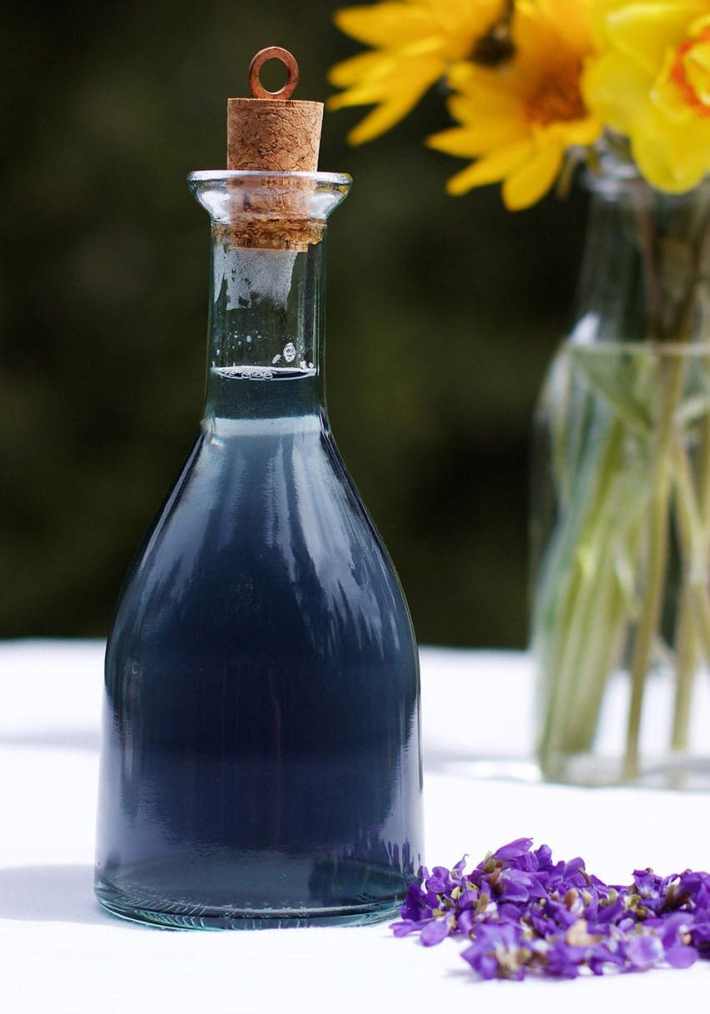
No lemon juice added
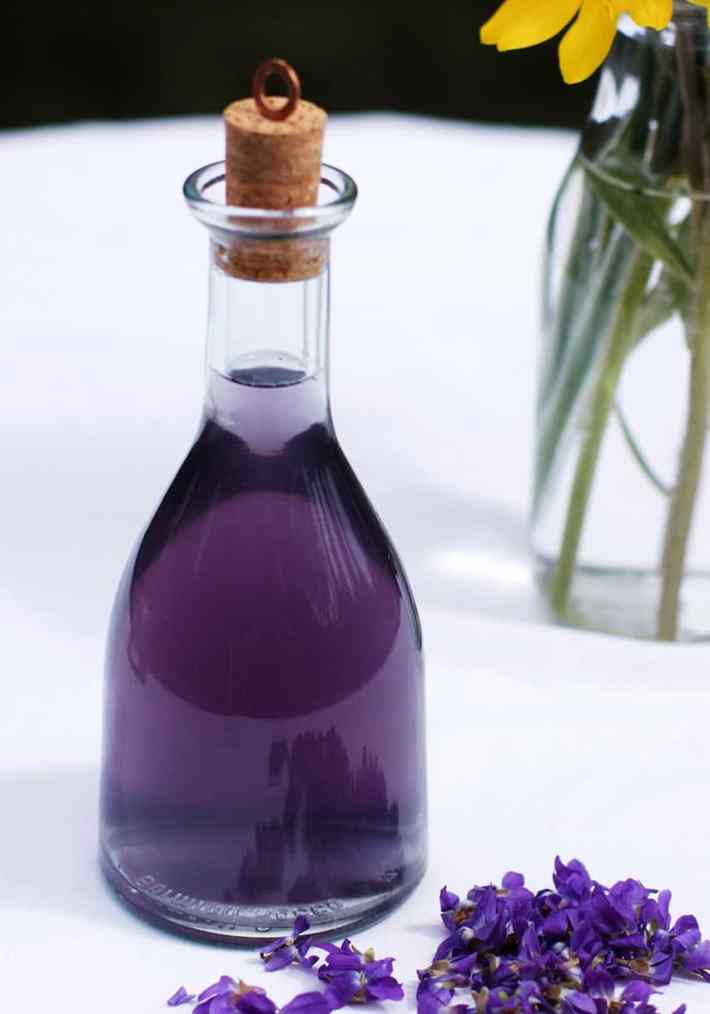
Lemon juice added
- Add honey (or sweetener of choice). Stir well.
- Store in the fridge and use within a few days. For a longer shelf life, measure the liquid, add an equal volume of honey or sugar, and use within a month. Discard if it develops mold.
Yield: Approximately 2 cups
An Entirely Different Option: Blue Butterfly Pea and Marshmallow Tea
Are you excited to make a blue syrup but don’t have access to violets right now? Here’s another alternative that uses the mucilage of marshmallow root (Althaea officinalis) and the intense blue coloring of butterfly pea flower (Clitoria ternatea).
What you’ll need…
- Pinch of dried butterfly pea flowers
- 1 to 2 tablespoons just-boiled water
- 1/4 cup dried chopped marshmallow root
- 2 cups lukewarm water (approximately)
- Sweetener of choice (optional)
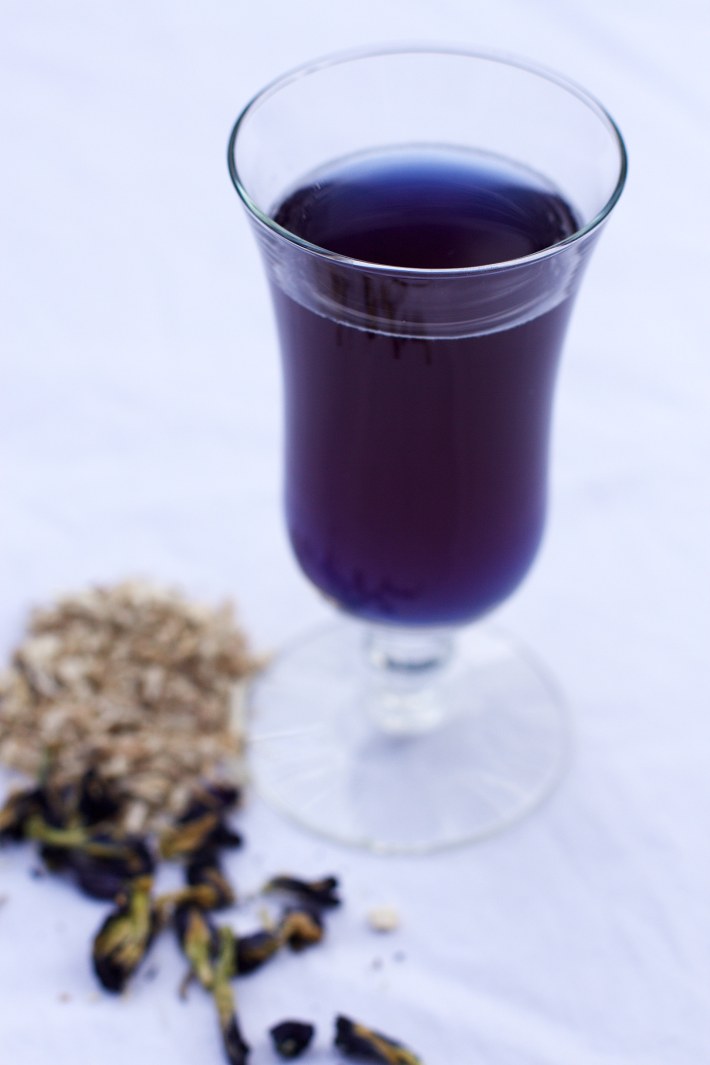
- Place the dried butterfly pea flowers in a pint-sized glass jar.
- Add the just-boiled water. Stir well and let sit for a minute or two. Stir the mixture again.
- Add the marshmallow root and then fill the jar with lukewarm water. Stir well.
- Let this sit for a minimum of 4 hours or overnight.
- Strain off the herbs. Sweeten as desired. Store in the fridge and use quickly.
Yield: 2 cups
While this isn’t the exact same as violet syrup, it’s a beautiful drink that can be used to soothe a sore throat, ease dry coughs, or as a beautiful garnish. You can read more about marshmallow infusions here.
Now I’d love to hear from you!
Have you made lovely potions with violet? Does this plant gladden your spring spirit?
Do you already love hibiscus? How do you like to use it?
Please share in the comments below.

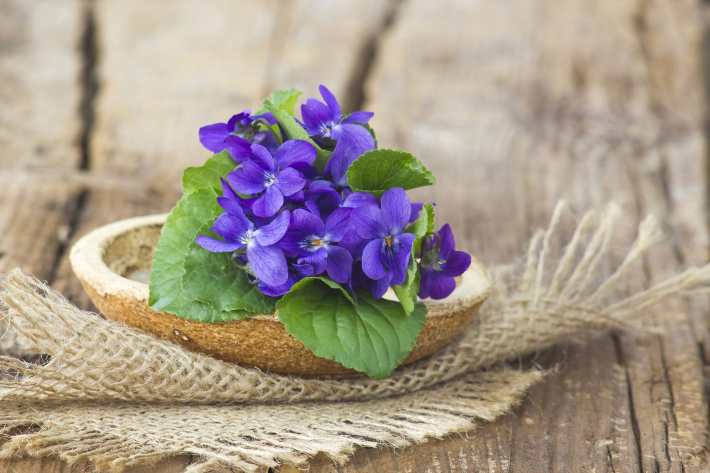
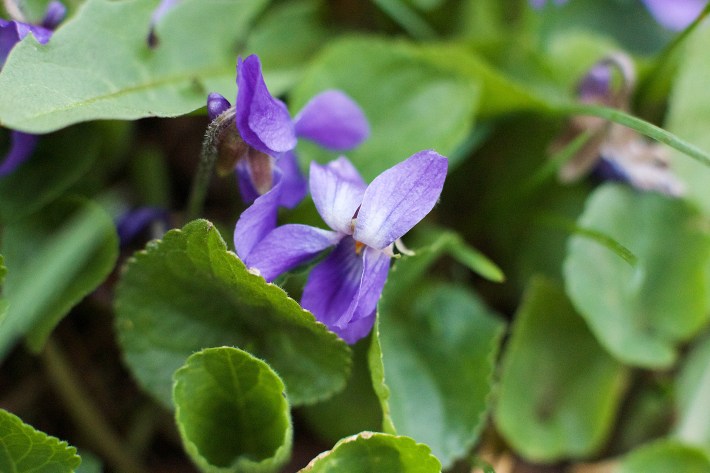
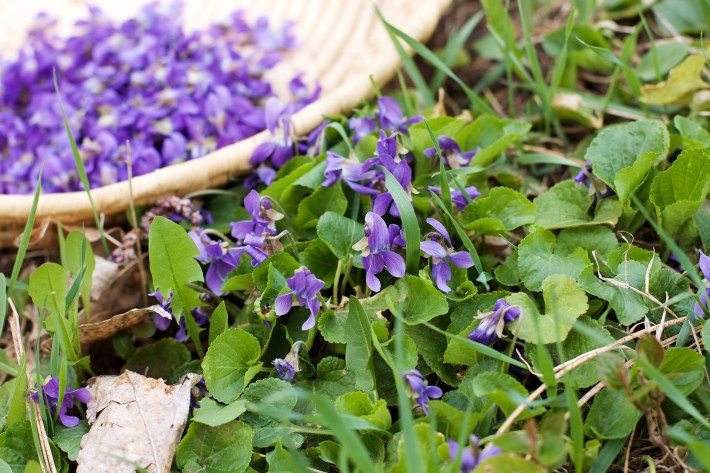
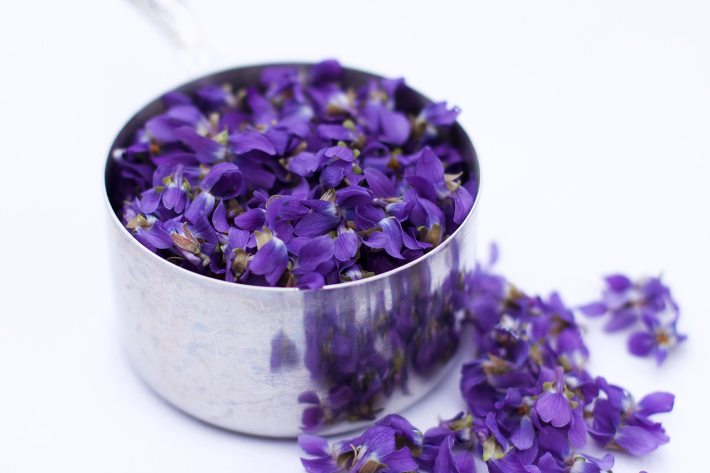

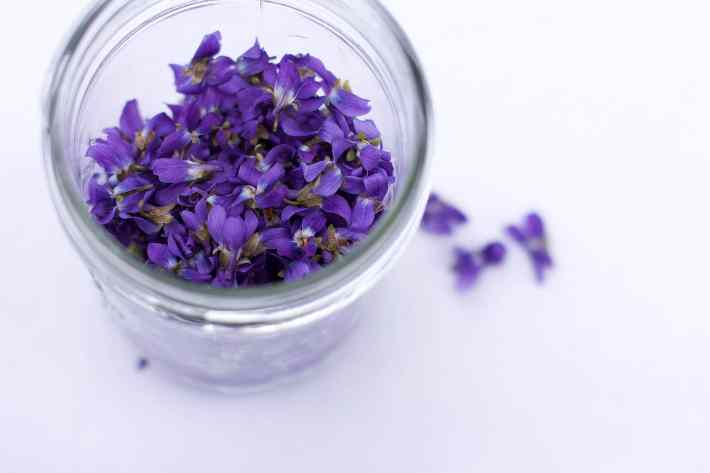
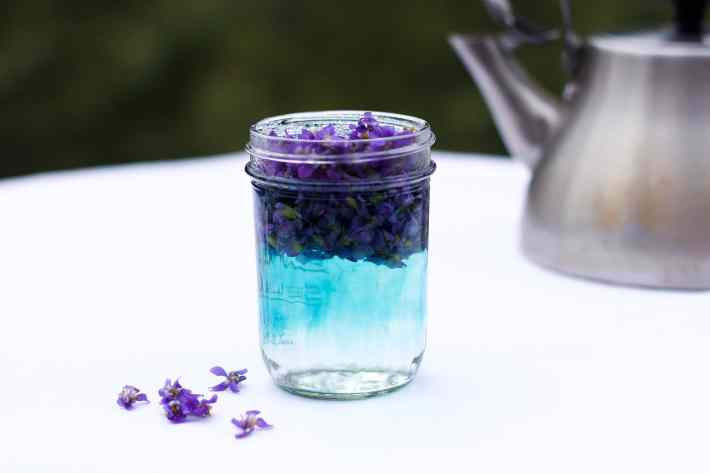



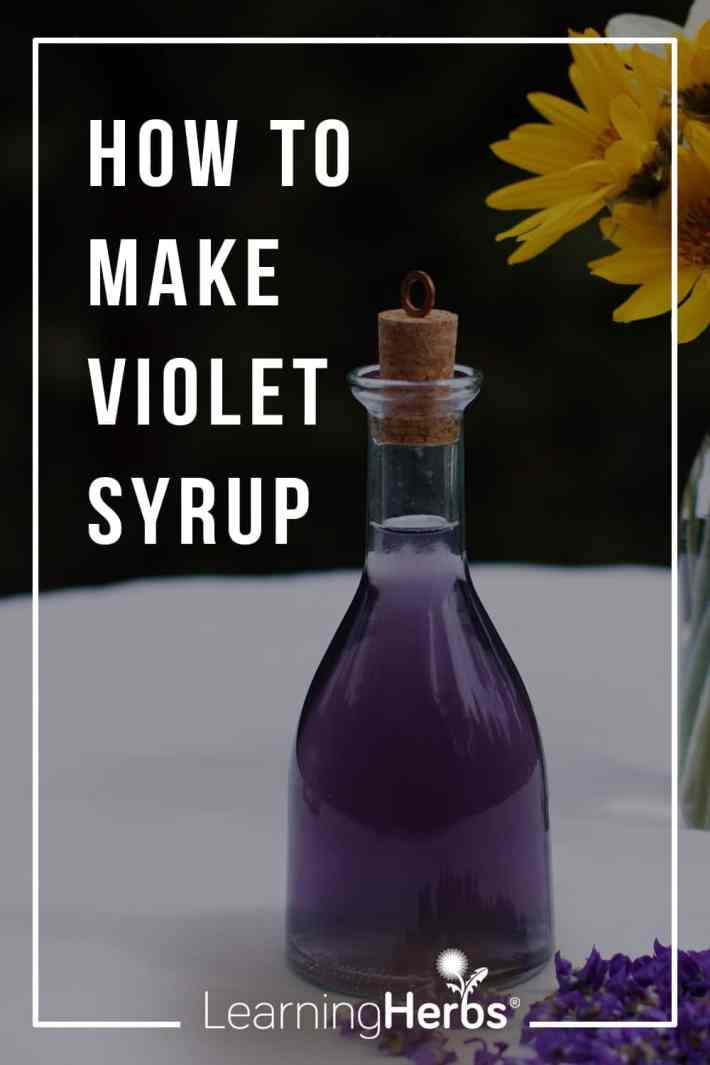







I don’t have any violets growing. Can I go to the garden center a a place like Walmart and buy pansies or johnny- jump ups and use those?
I’m honestly not sure how that would turn out since I’ve never done it. Could be a fun experiment – let us know if you try it!
If you’re going to try that, make sure the flowers you buy haven’t been pre-treated with pesticides!
I can’t wait to try this. How long does it last if I want to save it?
For the recipe as written, store in the fridge and use within a few days. For a longer shelf life, measure the liquid, add an equal volume of honey or sugar, and use within a month. Discard if it develops mold.
Rosalee, thank you for this information and the recipe. Violets are my absolute favorite flower. I have a few purple violets growing; they are scentless, but beautiful. I have a lot of Confederate violets, white with purple stripes. Are either of these two substitutes? I realize the final syrup will be a different color and perhaps taste, but will the medicinal properties be the same? Thank you for your attention in this and have a lovely, violet-filled day!
It will have a different taste and color, as you point out, but it can be used similarly in regards to medicine. Enjoy!
Thank you for your response and your expertise. Have a lovely weekend!
Growing up in Massachusetts, we had an abundance of violets. We would just pick them and eat them right from the ground (very yummy) never having to worry about if they had been sprayed with anything toxic. I will look for some violet seeds and try this recipe. It looks so beautiful.
Hi Rosalee, Violet syrup sounds beautiful, I made the elderberry syrup last winter from the apothecary course. I would love to make tincture due to the fact it has a longer shelf life, not sure what that would be? I’m in the UK so can’t use your suppliers & wondered if you could send me a link or name of a vodka I can use please as none of them seem to be strong enough, many Thanks Shell 🌻
Hi Shell! For fresh violet tincture, 30-50% alcohol by volume (ABV) will work. Enjoy your violets!
Thank you for the lovely violet recipes!! I look forward to making them when the violets rebloom- all the first harvest went into violet vinegar and on to violet oxymel,
I use a few dried flowers of hibiscus in my probiotic water kefir to add a beautiful pink color -I call it my “pink drink” :-)
I love this, Cathryn! It is fun to use hibiscus and other herbs to make pretty drinks!
Wonderful recipe! Thank you, I am anxious to try it.
Hello, could I use dry flowers? using half quantity maybe?
Thank you for this récipe,
Love,
Elisabeth
In general, Elisabeth, this is exactly how you would substitute dried for fresh. Use half the fresh quantity for dried. Perhaps give it a try and see how it goes.
Can I use pharmaceutical grade vegetable glycerine instead of honey?
You can certainly give it a try. Let us know how it turns out!
So sad violets are no longer in bloom. I’ll need to wait until next year ☹️ Perhaps I’ll give the pea and marshmallow a try. I’d have order the butterfly pea flower online. May be the next thing to add to my herb garden.
Thank you so much! Are there any varieties that grow in central Texas that are safe to use?
Hi Shelley! You may find this link useful, as it shows species across North America: https://plants.usda.gov/core/profile?symbol=viola
All species of violet are safe to use. Enjoy!
Can I freeze it into ice cube trays to save for a longer period of time ?
Absolutely! Enjoy :)
Hello! Thank you for the very informative article. I just ran out to a nearby field and picked a whole yogurt tub full of violets – the field is packed with them! I am wondering, can I let the flowers dry out, then store them for usage as tea? If so, do I just steep them like you’ve shown in this article? Thanks so much!
Yes, you certainly can. When using dried flowers, use half as much as the recipe calls for the fresh flowers. Enjoy!
God bless you sir,I enjoyed the teachings
I knew about this for quite some time, but I still use tea as the basis for drinking. And add violet to it. It turns out very tasty in fact. I have not consumed sugar for more than a year and am trying to please my taste buds with some delights. For example the same violet. She also wonders if the syrup will lose its property in frozen form if it is drunk, for example with coffee. I just have my own grass garden, in which there is a greenhouse where a variety of herbs grow all year round.
I wondered how they change colour. thank you for sharing and will definitely try.
Our family loves violet honey short mead…the energetic essence of these sweet, heady, uplifting flowers comes through in a pretty ecstatic way!
I preserve freshly harvested violet flowers in straight honey, and then I can use them in a variety of ways by dipping into the honey jar.
I use violets as a balm for grief, supporting breast health, and for soothing herbal baths and steams.
It’s a treat to just spend time with these tiny beauties in the springtime.
I had such a fun time foraging for violets this morning! I came back and made Rosalie’s awesome syrup. Wish I could send you a pic. I’ll tag you on Instagram to be sure!!
Yay! I am so glad to hear you had fun foraging this morning!
Hello! I was wondering if we could freeze the syrup, to perhaps save it for winter use? Do you think that would work?
Hello everyone i Am williams pater and i am from USA i am here to give my testimony about an herbal doctor called Dr,olu I was heartbroken because i had very small penis,not nice to satisfy a woman, i have been in so many relationship, but cut off because of my situation, i have used so many product which doctors prescribe for me, but could not offer me the help i searched for. i saw some few comments on the internet about this specialist called Dr,OLU and decided to email him on his email i saw on the internet,(drolusolutionhome@gmail.com ) so I decided to give his herbal product a try. i emailed him and he got back to me, he gave me some comforting words with his herbal product for Penis Enlargement, Within three weeks of me use it, i began to feel the enlargement, ” and now it just 4 weeks of using his products my penis is about 8 inches longer, and i had to settle thing out with my ex girlfriend , i was surprised when she said that she is satisfied with my performance in bed and i now have a large penis.thanks to DR OLU for is herbal product. you can also reach him with emsil drolusolutionhome@gmail.com though is..number WHATASPP him today on this number [ +2348140654426 ]